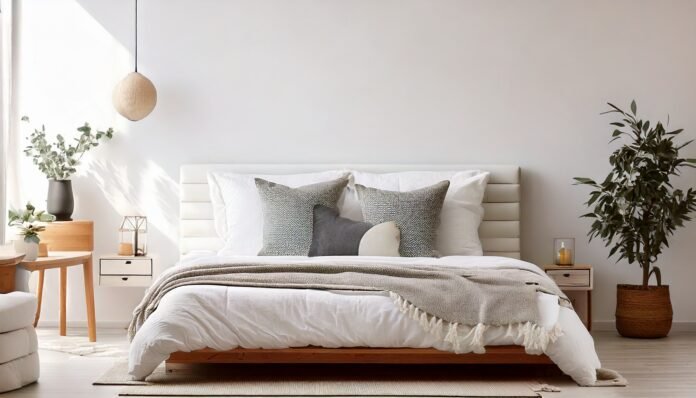Introduction: Finding Peace in Simplicity
I never thought I’d become a minimalist. For years, my bedroom resembled what I can only describe as an “organized chaos” situation—clothes draped over every surface, trinkets covering my dresser, and about five too many throw pillows competing for space on my bed. Nights were restless, mornings were stressful, and I couldn’t figure out why I felt so overwhelmed in what should have been my sanctuary.
Then came the great flood of 2022 (okay, it was just a broken pipe, but the drama feels warranted). After losing some of my possessions to water damage, I was forced to strip my bedroom down to the essentials. Something unexpected happened—I slept better. I woke up feeling clearer. Getting dressed became easier. That accidental minimalism taught me that less truly can be more, especially in the space where we begin and end each day.
This guide isn’t about creating a stark, uncomfortably bare room that looks good in photos but feels unlived. It’s about intentionally crafting a bedroom that serves your needs, calms your mind, and, yes—looks beautiful too. Whether you’re working with a tiny apartment bedroom or a larger space, these principles will help you transform your bedroom into a minimalist oasis that actually improves your quality of life.
Understanding True Minimalism: Beyond White Walls
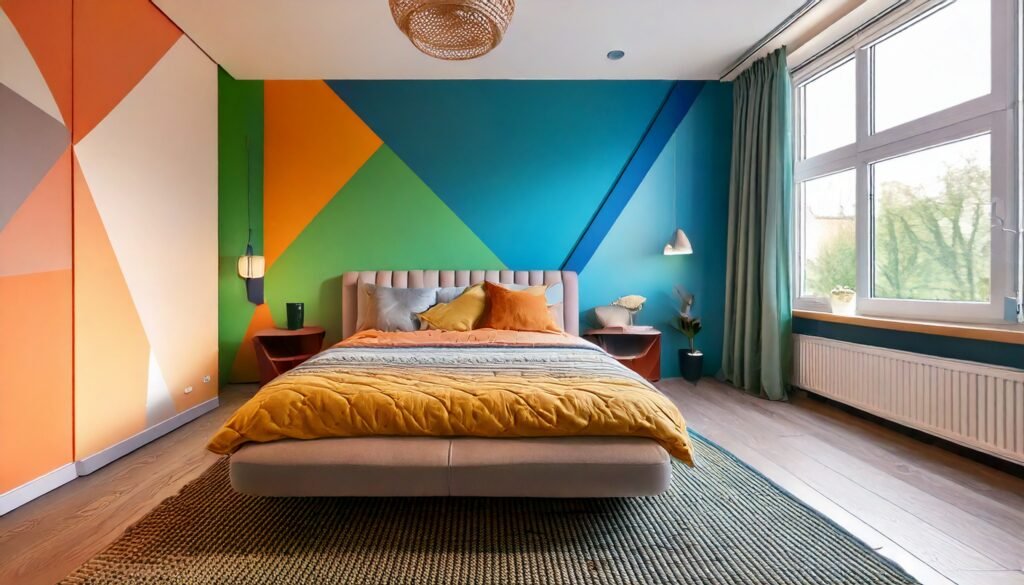
Let’s clear something up right away—minimalism doesn’t mean your bedroom needs to look like a sterile hospital room or a pretentious furniture showroom. The biggest misconception I hear from friends is, “I could never do minimalism because I like color/texture/personality too much!”
True minimalism is about intentionality, not deprivation. It’s asking, “Does this item serve a purpose or bring me genuine joy?” rather than “How little can I live with?” My minimalist bedroom has a gorgeous deep blue accent wall and a handwoven blanket my grandmother made—neither of which I’d ever part with because they bring me daily happiness.
The goal is to remove what’s unnecessary so what’s meaningful can shine. Think of it as curating rather than depriving. When everything in your bedroom has earned its place, the result is naturally more peaceful and aesthetically pleasing.
Step 1: The Great Purge (With Kindness)
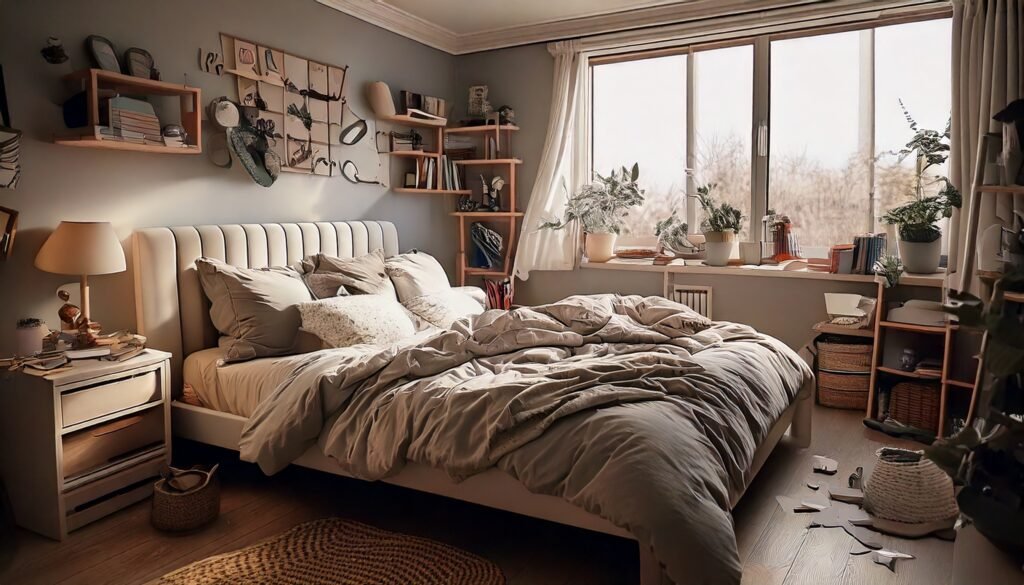
Before bringing in any new minimalist decor, we need to address what’s already there. This might be the hardest part, but I promise it gets easier—and even addictive—once you start seeing results.
Start by setting aside a full day (or weekend if your collection of stuff runs deep) and tackle your bedroom in sections:
- Clothing: Try the backward hanger trick that changed my life—hang everything backward, and only return items to the normal position after you’ve worn them. After three months, anything still backward likely isn’t serving you.
- Bedside tables: These tend to become catch-all surfaces. Keep only what you use daily—perhaps a lamp, your current book, and a glass of water. My rule: if I haven’t touched it in a week, it doesn’t deserve bedside real estate.
- Decorative items: Ask yourself honestly: “Would I buy this again today?” If the answer is no, thank it for its service and let it go. I had a collection of decorative boxes that had followed me through three moves. When I finally questioned why I was keeping them, I realized they were just gathering dust and mental weight.
- Furniture: This is where many bedrooms go wrong. Do you actually need that extra dresser, or could your closet work harder? Could the bulky nightstands be replaced with floating shelves? Every piece of furniture should earn its keep through function.
Remember, this isn’t about tossing everything into a dumpster. Rehome quality items through donation, selling, or gifting to friends. I found it much easier to part with things when I knew they’d be used and appreciated by someone else.
Step 2: The Minimalist Bedroom Design Framework
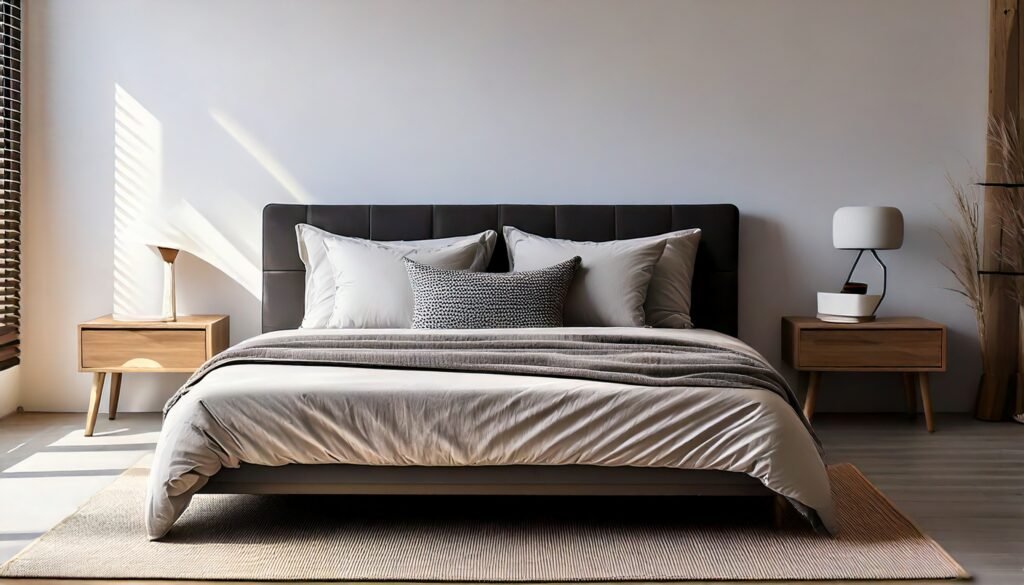
With the clutter gone, it’s time to design your space using these core principles thoughtfully:
Focus on the Bed
In a minimalist bedroom, the bed naturally becomes the focal point. Invest in quality here—a comfortable mattress and simple, natural fiber bedding in neutral tones create an inviting centerpiece that doesn’t overwhelm the space.
I spent years with a colorful duvet and seven decorative pillows that I’d throw on the floor every night (who was I trying to impress?). Switching to crisp white linen with just two sleeping pillows and one accent pillow was revolutionary. Making my bed takes 30 seconds now, and it always looks magazine-worthy.
Thoughtful Color Selection
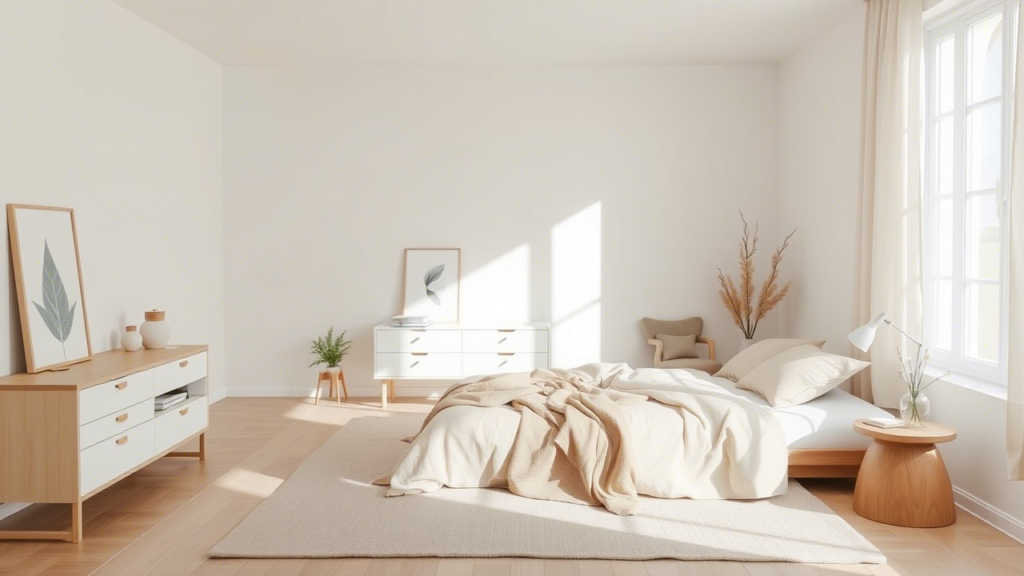
Contrary to popular belief, minimalist bedrooms don’t have to be all white. The key is choosing a restrained palette of 2-3 complementary colors and sticking to them consistently.
My bedroom uses white walls with natural wood tones and deep navy blue accents. The limited palette creates cohesion even as seasons and trends change. When I’m tempted by a bright yellow throw pillow while shopping, I simply remind myself it’s not in my bedroom’s color story—decision made, money saved.
Natural Light and Space
Maximizing natural light is non-negotiable in minimalist design. Remove heavy curtains in favor of simple blinds or sheer fabrics that provide privacy without blocking light. Position mirrors strategically to reflect light into darker corners.
The most transformative change I made was rearranging furniture to create more open floor space. Just having room to walk comfortably around my bed made the entire room feel larger and more peaceful. Don’t underestimate the luxury of space—it’s what separates a minimalist oasis from a standard bedroom.
Step 3: Clever Storage Solutions That Maintain Minimalism
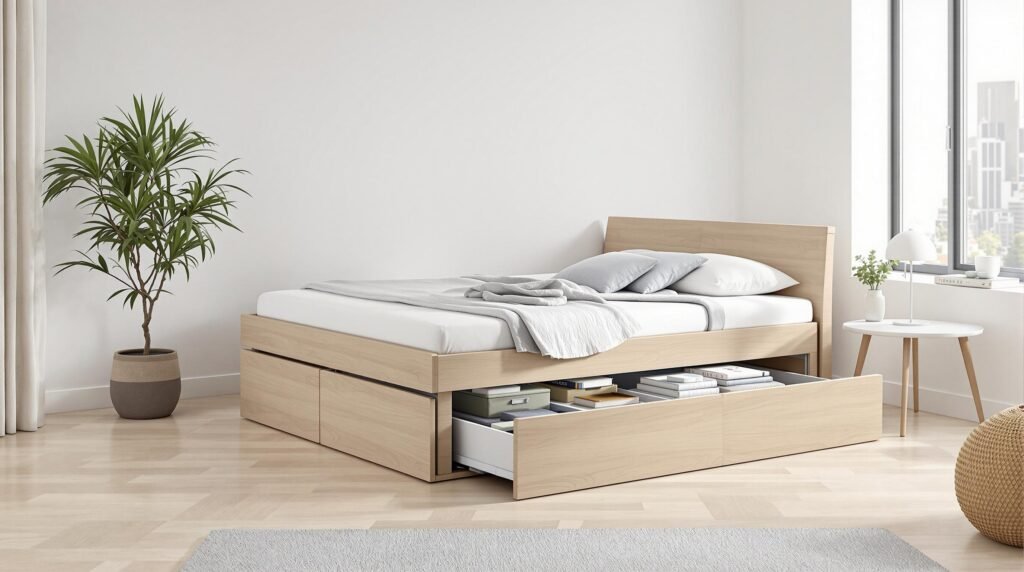
The secret to successful minimalist living isn’t necessarily owning less (though that helps)—it’s having thoughtful storage that keeps possessions out of sight but easily accessible.
Under-Bed Brilliance
The space under your bed is prime real estate. Low-profile storage boxes on wheels can house seasonal clothing or extra bedding without creating visual clutter. I use simple canvas drawers that disappear beneath my bed skirt—out of sight but organized and accessible when needed.
Closet Systems That Work Harder
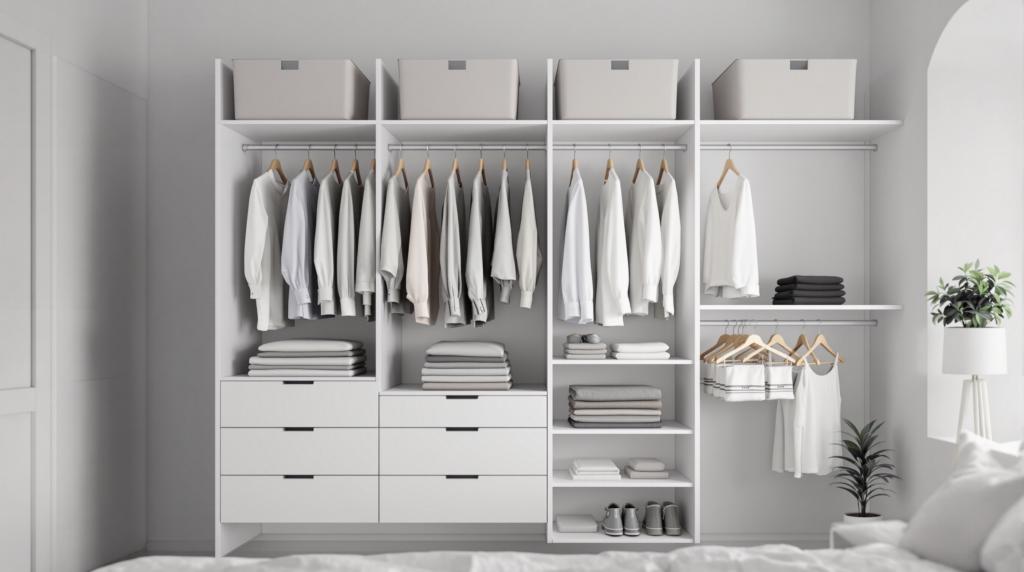
A well-organized closet means you need fewer storage pieces in your actual bedroom. Consider investing in a customizable closet system with adjustable shelving, drawers, and hanging space tailored to your specific needs.
The game-changer for my small closet was installing a second hanging rod beneath my existing one, instantly doubling hanging capacity. I also replaced mismatched hangers with slim velvet ones that prevent slipping and create a visually cohesive look—a small touch that makes opening my closet a pleasure rather than a stress trigger.
Invisible Storage
Look for furniture that pulls double-duty as storage without looking like storage. A platform bed with built-in drawers, a bench at the foot of your bed with storage inside, or floating nightstands with hidden compartments maintain clean lines while providing function.
My favorite invisible storage solution: I replaced my traditional dresser with a streamlined console table that has three discrete drawers. It holds folded clothes without dominating the room visually and doubles as a display surface for just a few meaningful items.
Step 4: Minimalist Decor That Still Feels Personal
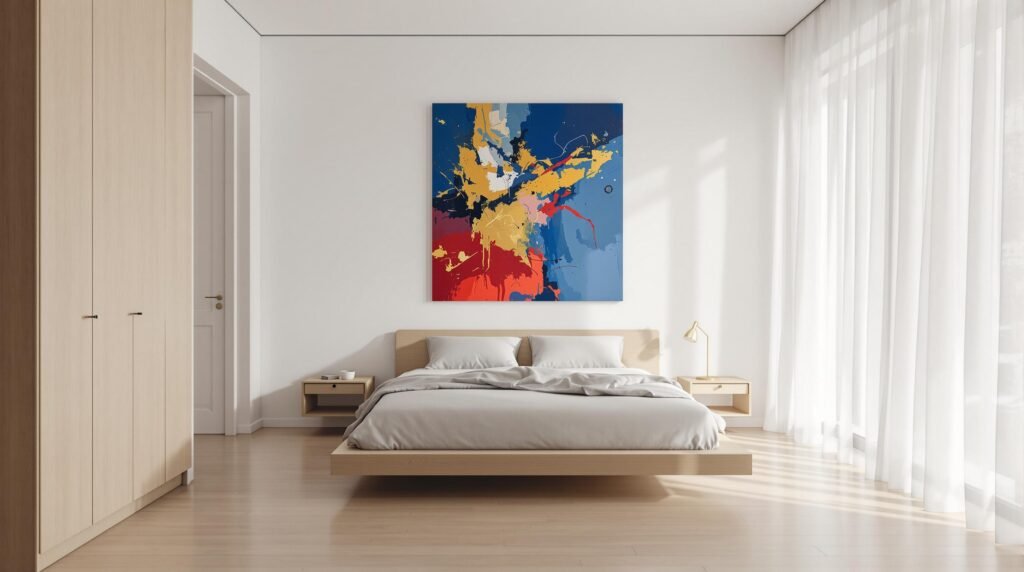
Here’s where people often get stuck—how do you create a space that feels like you without accumulating decorative clutter? The answer lies in quality over quantity and meaningful curation.
The One-In-One-Out Rule
For every new item I bring into my bedroom, something else has to go. This simple principle prevents accumulation and forces me to consider whether I truly love something enough to replace an existing item.
When I found a handmade ceramic vase at a local art fair last summer, I knew immediately which mass-produced vase it would replace. The new piece brings me genuine joy every time I see it, partly because it’s not lost among dozens of other decorative objects.
Thoughtful Art Selection
Choose one statement piece rather than a gallery wall of smaller items. A single large-scale photograph or painting creates focus without overwhelming the space.
In my bedroom, I have just one oversized black and white photograph above my bed—a misty mountain landscape I took during a meaningful solo trip. It’s personal calming, and makes more impact standing alone than it would among a cluttered collection.
Living Elements
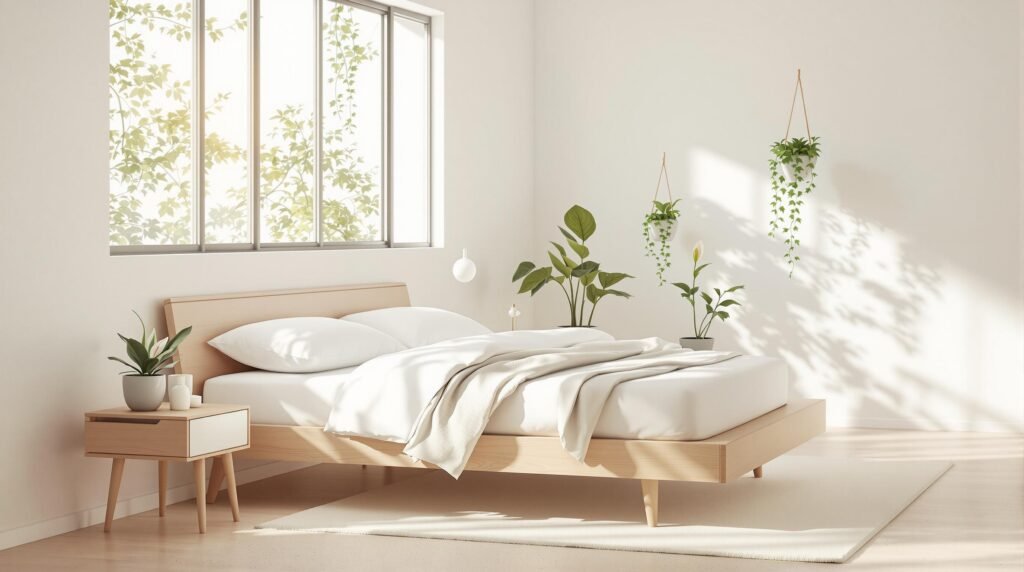
Plants bring life, texture, and subtle color to a minimalist space without feeling like clutter. Choose 1-3 well-placed plants in simple pots that complement your color scheme.
My fiddle leaf fig has become both a design element and a mindfulness practice—its care routine grounds me each weekend. Against my white walls, its organic shape and rich green color provide the perfect natural accent.
Step 5: Creating a Technology-Free Sanctuary
One often-overlooked aspect of minimalist bedroom design is the role of technology—or, ideally, its absence. Our bedrooms should be sanctuaries for rest, not extensions of our workspaces.
After realizing I was checking emails in bed at midnight and again before even getting up, I made a radical change: no screens in the bedroom. The TV was relocated to the living room, my laptop was banned, and my phone charged overnight in the hallway.
The difference in my sleep quality was immediate and profound. Without the blue light and mental stimulation, I fall asleep faster and wake more refreshed. If you absolutely need your phone nearby (for alarms or emergency calls), consider a dedicated charging station inside a drawer to keep it out of sight and mind.
Step 6: Maintaining Your Minimalist Oasis
Creating a minimalist bedroom takes effort, but maintaining it is where the real challenge—and reward—lies. These simple daily habits will help preserve your peaceful space:
- The Two-Minute Rule: If something takes less than two minutes to put away, do it immediately. This prevents small messes from accumulating into overwhelming clutter.
- Evening Reset: Take five minutes before bed to reset your room—return items to their homes, clear surfaces, and prepare for a fresh start tomorrow. I find this ritual not only keeps my space tidy but signals to my brain that it’s time to wind down.
- Seasonal Reassessment: Every three months, take an hour to evaluate what’s working and what isn’t. Are there items you thought you’d use but haven’t touched? Has something new crept in that doesn’t align with your intentional design? This regular check-in prevents backsliding into old, cluttered habits.
My most effective maintenance trick is actually the simplest: I take a photo of my bedroom when it’s perfectly clean and organized. When I’m tempted to let things slide, that visual reminder of how peaceful my space can be motivates me to maintain it.
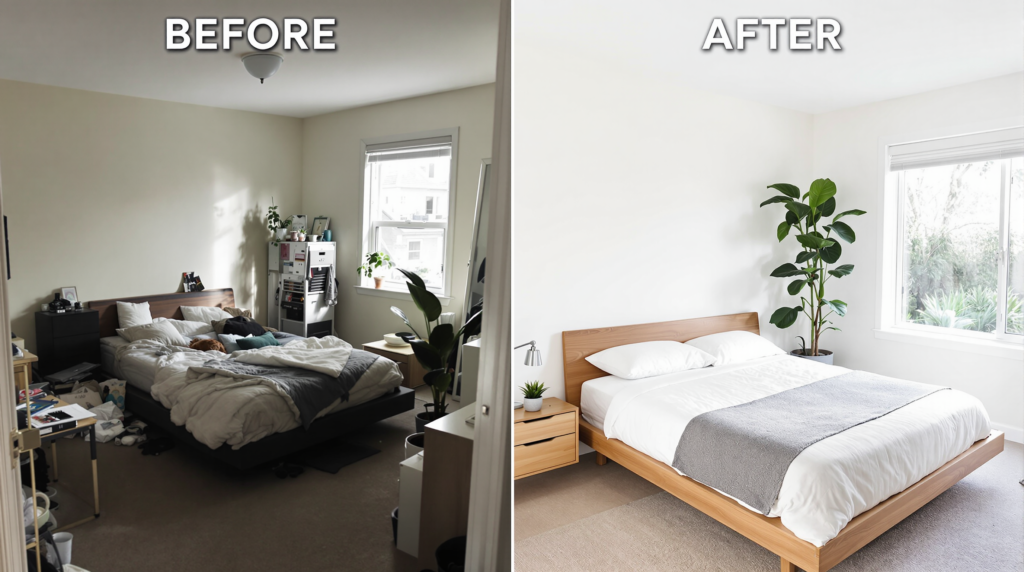
Conclusion: Your Minimalist Bedroom Journey
Your minimalist bedroom won’t look exactly like mine, nor should it. True minimalism is deeply personal—it’s about creating space for what matters to you, not adhering to someone else’s aesthetic rules.
Start with small changes if a complete overhaul feels overwhelming. Maybe begin with just your bedside table this weekend, then tackle your closet next month. Each simplified area will motivate you toward the next step.
Remember that minimalism isn’t a destination but a continuous practice of intentional choices. There will be times when things accumulate, and that’s okay—just return to these principles when you’re ready to reset.
I’d love to hear about your minimalist bedroom transformations! What challenges are you facing? What unexpected benefits have you discovered? Share your journey in the comments below, or tag me in your before-and-after photos on social media.
Ready to transform your bedroom into a minimalist sanctuary? Start with just one drawer today. Your future well-rested self will thank you.
FAQ: Minimalist Bedroom Design
Q: Won’t a minimalist bedroom look cold and uninviting?
A: Not if you do it thoughtfully! The key is balancing clean lines with warm elements like natural wood, soft textiles, and perhaps one or two meaningful decorative pieces. My minimalist bedroom feels more inviting than my previously cluttered space because each element was chosen intentionally.
Q: I share a bedroom with my partner, who isn’t interested in minimalism. How can we compromise?
A: Focus on your possessions first, and lead by example rather than pressure. Negotiate for specific areas that can remain simplified (perhaps the shared nightstand or dresser top). Many partners become more interested in minimalism once they experience the benefits of even partially decluttered spaces. My husband was initially resistant but became a convert after seeing how relaxed he felt in our simplified bedroom.
Q: How do I maintain minimalism with limited storage in my home?
A: First, be more ruthless about what you must keep. For items you genuinely need but use infrequently, consider under-bed storage, vacuum bags for seasonal items, or furniture pieces that incorporate hidden storage. The most important strategy is to reassess and prevent accumulation in the first place regularly.
Q: What’s the biggest mistake people make when creating a minimalist bedroom?
A: Focusing too much on the aesthetic and not enough on functionality. A beautiful minimalist bedroom that doesn’t meet your practical needs won’t be sustainable. Make sure you have adequate storage for your actual possessions, a comfortable place to sleep, and the items you genuinely use daily before worrying about achieving a specific “look.”
Q: How much should I expect to spend on creating a minimalist bedroom?
A: Minimalism doesn’t have to be expensive—in fact, it often saves money in the long run since you’re buying less. Focus first on removing what doesn’t serve you, then invest selectively in quality basics like good bedding and practical storage solutions. Many minimalist transformations can be achieved simply by editing what you already own and rearranging it for better functionality.

